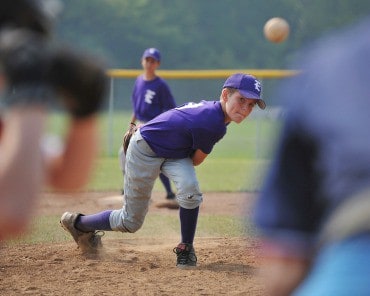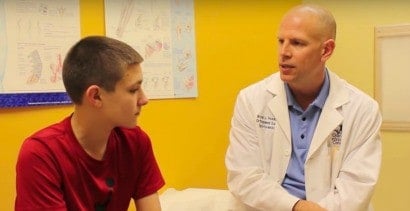Getting Back on the Baseball Diamond After Forearm Fractures
- What are Forearm Fractures?
- How Are Forearm Fractures Treated?
- What is Arm Reconstruction Surgery and How is it Performed?
- What is the Recovery Process for Arm Reconstruction Surgery?
When Jacob sustained forearm fractures in two places, his parents initially brought him to a children’s hospital for treatment. After two weeks, the bones were still not in place and weren’t healing properly. At a loss for what to do, Rhonda, Jacob’s mother, turned to friends and family for advice.
Through a recommendation from her boss, Rhonda turned to Bryan L. Reuss, M.D., a double board certified orthopaedic surgeon and sports medicine specialist at Orlando Orthopaedic Center, to help get Jacob back on the baseball field.
“We got a phone call within ten minutes of the clinic hearing the story about Jacob,” Rhonda recalls. “We were in the office the very next day, with surgery scheduled for the day after that; and, six weeks after having surgery, my son is playing baseball, running, jumping, and sliding into bases, which is absolutely amazing.”
Jacob adds: “I was really excited to find out that I was going to be able to play baseball again.”
What Are Forearm Fractures?
The forearm (the area bounded by the wrist and the elbow) is comprised of two bones: the radius and the ulna. Forearm fractures represent more than 40 percent of all juvenile fractures, and three-quarters of forearm breaks in children happen near the wrist. The healing process in children’s bones occurs faster than in adults, so it is crucial to treat children’s fractures right away, to avoid complications later on.
In general, the bones of the forearm can crack slightly, or they can fracture into many fragments. In the extreme case of an open fracture, a bone will crack in an awkward way, leaving it sticking out through the skin, needing urgent medical care due to the risk of infection.
In adults, the most common causes of a forearm fracture are a direct blow, falling on an outstretched arm, often during sporting activities, or as a result of a motor vehicle accident. Both the radius and ulna are usually broken at the same time, because of the immense power needed to break either bone at its center point.
“When my husband and I first met Dr. Reuss, we felt very comfortable and at ease,” says Rhonda. “He was very knowledgeable about the break and about what could be done to fix it. He left all the decisions up to us, but he walked us through everything, from the beginning to the end of surgery.”
How Are Forearm Fractures Treated?
When a single bone has been fractured and is not out of alignment, a cast or brace alone may be able to repair it. Regular visits to your orthopaedic surgeon will be needed to keep an eye on the healing process, as a shifting in the position of the bones may require the patient to undergo a surgical procedure to restore the fracture.
If both the ulna and the radius are fractured, or if the patient has suffered an open fracture, surgery is often required to treat the injury to return to regular daily activity without long-term issues. Your orthopaedic surgeon may want to wait until the swelling has subsided before operating.
What is Arm Reconstruction Surgery and How is it Performed?
 “The most typical form of surgery to repair forearm fractures, an operation that is known as an open reduction, involves fixating the bones with plates and screws,” says Dr. Reuss. “We’ll begin by opening the skin, realigning the bones, and then holding them together with screws and metal plates, fastened to the exterior surface of the bone. This is what had to be completed in Jacob’s case.”
“The most typical form of surgery to repair forearm fractures, an operation that is known as an open reduction, involves fixating the bones with plates and screws,” says Dr. Reuss. “We’ll begin by opening the skin, realigning the bones, and then holding them together with screws and metal plates, fastened to the exterior surface of the bone. This is what had to be completed in Jacob’s case.”
In another type of procedure, the surgeon will place a metal rod embedded in the center of the bone, where bone marrow is found. And in extreme cases, where the bones and skin have been badly injured, and the risk of infection is high, an external fixation may be used. Steel pins are inserted into the bone over and under the site of the break; the pins will be fastened to a bar away from the skin, keeping the bones in a stable position so they can heal properly.
“When Jacob was done with surgery, I was so impressed by how Dr. Reuss explained all the procedures he performed, the things he found, and what we could expect after surgery,” says Rhonda.
What is the Recovery Process for Arm Reconstruction Surgery?

Rhonda and Jacob arm reconstruction surgery
“Our bones have great healing capacity, and forearm bones normally mend completely within three to six months,” says Dr. Reuss. “Recovery depends on the severity of the fracture, and on each patient’s medical history.”
In nonsurgical care, rehabilitation of the arm can begin after keeping the arm immobilized for several weeks in a cast. A physical therapist can support the healing process by providing exercises for increasing mobility and building up strength.
After surgical treatment, a cast or brace might be needed for between two to six weeks after the procedure. To limit stiffness, your surgeon may provide you with gentle mobility exercises, to be started soon after surgery. Your physician may also recommend a physical therapist. Depending on each patient’s fracture and type of surgery, the surgeon will determine when the patient can go back to work and resume sporting activities.
The plates and screws inserted during surgery normally stay in place permanently. Patients wishing to remove the metal fasteners will need to wait one or two years to schedule the removal procedure.
“As a mom,” says Rhonda, “I felt very comfortable bringing Jacob here to Orlando Orthopaedic. The staff and the whole team were outstanding. Dr. Reuss was, above all, the best I’ve ever encountered. I would not hesitate to bring my children back here.”
What is Arm Reconstruction Surgery and How is it Performed?
“The most typical form of surgery to repair forearm fractures, an operation that is known as an open reduction, involves fixating the bones with plates and screws,” says Dr. Reuss. “We’ll begin by opening the skin, realigning the bones, and then holding them together with screws and metal plates, fastened to the exterior surface of the bone. This is what had to be completed in Jacob’s case.”
In another type of procedure, the surgeon will place a metal rod embedded in the center of the bone, where bone marrow is found. And in extreme cases, where the bones and skin have been badly injured, and the risk of infection is high, an external fixation may be used. Steel pins are inserted into the bone over and under the site of the break; the pins will be fastened to a bar away from the skin, keeping the bones in a stable position so they can heal properly.
“When Jacob was done with surgery, I was so impressed by how Dr. Reuss explained all the procedures he performed, the things he found, and what we could expect after surgery,” says Rhonda.



